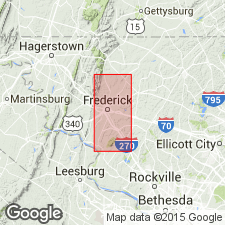
- Usage in publication:
-
- Adamstown Member*
- Modifications:
-
- Named
- Biostratigraphic dating
- Dominant lithology:
-
- Limestone
- AAPG geologic province:
-
- Piedmont-Blue Ridge province
Summary:
Named as middle member of Frederick Formation (revised). Named for Adamstown, Frederick Co., north-central MD. Good exposures are just east of Adamstown; measured section at Lime Kiln. No complete exposures. Consists of thinly to thickly bedded, flaggy limestone beds interrupted by three traceable megaclastic limestone zones. Thinly bedded (1 to 5 cm) limestone is medium to dark gray, argillaceous with shaly and (or) dolomitic tops; contains sparse burrows. Thickly bedded limestone is coarse, peloidal, and megaclastic (micrite clasts in dolomitic microspar matrix or coarser calcite sparry cement). Thickness of entire member is 325 m. Transition to overlying Lime Kiln Member (new) is marked by first appearance of quartz and (or) coarse peloidal sediments in thinly or thickly bedded limestone. Differs from underlying Rocky Springs Station Member (new) in that quartz sand is conspicuously absent from and biogenic content increases in the Adamstown. Age is Late Cambrian. Fossils include trilobites, brachiopods, and echinoderms of late Franconian or early Trempealeauan age (M. Taylor, 1972, personal commun). [Author assigns Franconian age only in table 1.] Report includes geologic map and sections, geologic columns, measured sections, correlation charts, and fossil lists.
Source: GNU records (USGS DDS-6; Reston GNULEX).
For more information, please contact Nancy Stamm, Geologic Names Committee Secretary.
Asterisk (*) indicates published by U.S. Geological Survey authors.
"No current usage" (†) implies that a name has been abandoned or has fallen into disuse. Former usage and, if known, replacement name given in parentheses ( ).
Slash (/) indicates name conflicts with nomenclatural guidelines (CSN, 1933; ACSN, 1961, 1970; NACSN, 1983, 2005, 2021). May be explained within brackets ([ ]).

